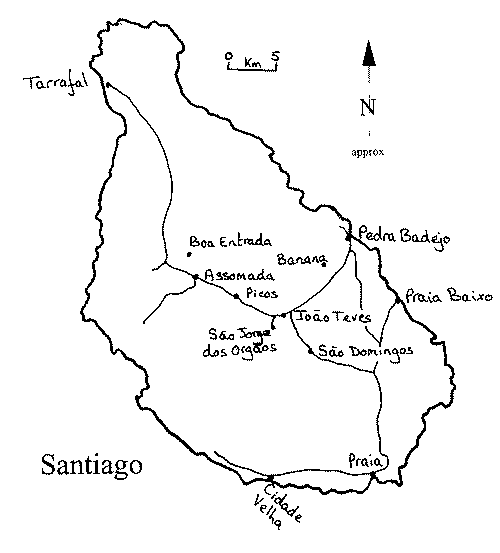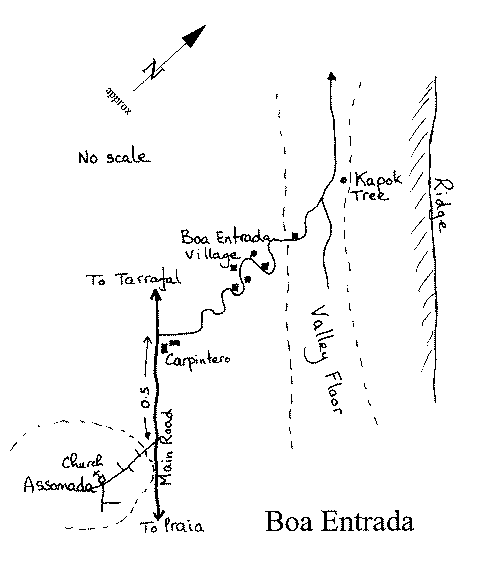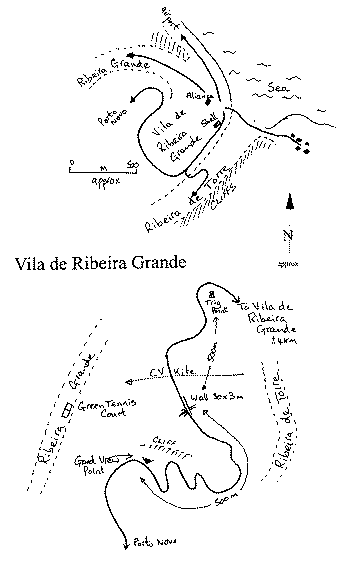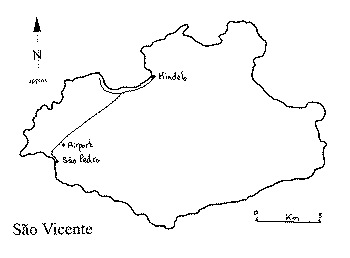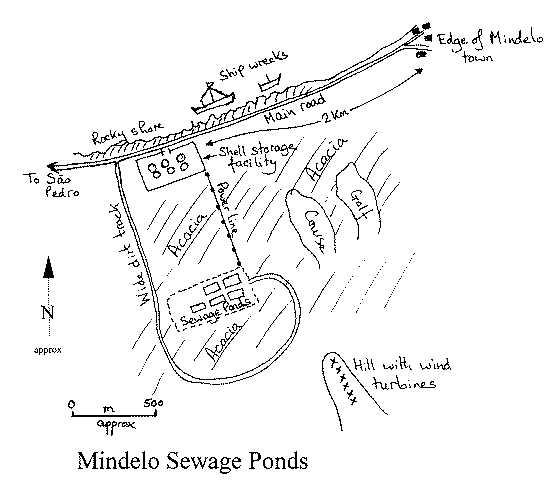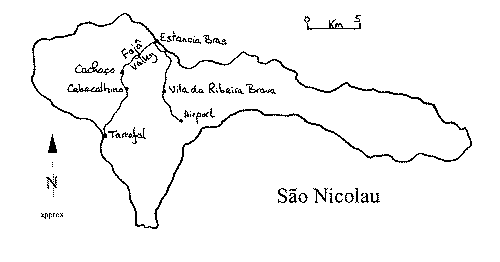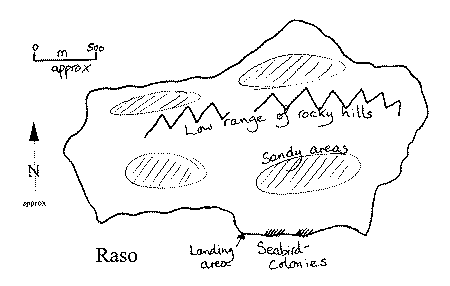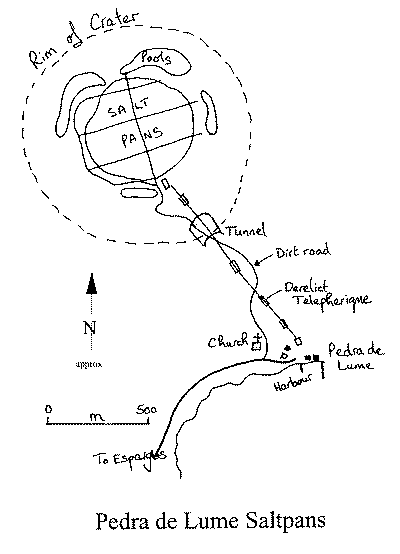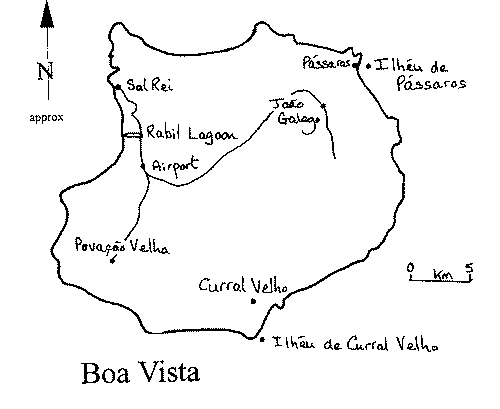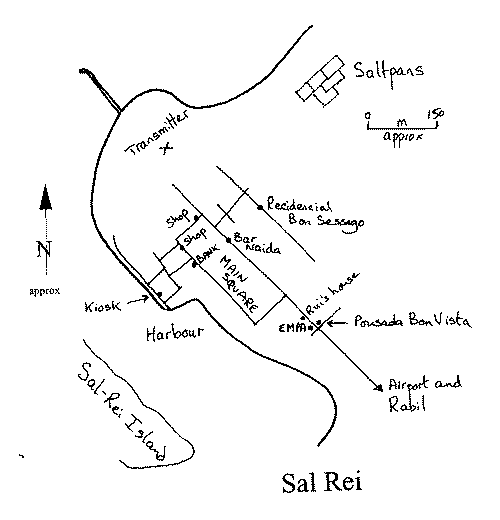Section 1 - Introduction, logistics, itinerary and general information.
Section 2 - Birding sites.
Section 3 - Systematic list.
Birding Sites
Included below are details of accommodation, access, habitat and a species list for each site. Species that were personally seen or heard are indicated by the number seen/heard, or with a 'c' to denote that the bird was common or fairly so at that site. Species listed without a number have been recorded there, but by observers other than me. Bold typeface identifies species of particular note; either rare, endemic, or which might be considered a 'target' bird at that locality. These sites are listed in the order in which they were visited.
Site 1. Praia, Santiago
Although international flights arrive at the international airport on Sal, the capital of Cape Verde is Praia, on Santiago. As Sal holds little of interest, and most of the endemics occur on Santiago, it is here that most birders will start their trip. As all sites on Praia can be reached easily in a day, it can be used as a base for covering several sites.
|
The town of Praia itself is divided on two levels. The central area and town centre are located on the upper tier, known as the 'plateau'. The surrounding lower area contains the port, harbour, houses and business areas. The airport is located a couple of kilometres east of town, with a taxi ride to the centre costing 200 CVEsc. The cheapest accommodation is the simple, basic but clean, Residencial Sol Atlantico (also known as Sal Atlantico) in the town centre. A room costs between 900 CVEsc (single without bathroom) to 1,900 CVEsc (double with bathroom). I paid 1,100 CVEsc for a single with bathroom. From the street this place looks like a run-down workhouse, and no sign is displayed outside indicating it as a Residencial. However, all the taxi drivers know it. It is conveniently located adjacent to a supermarket, and across the street from the TACV office. A little farther along the road one can find the Residencial Solmar which is slightly more expensive, and other establishments can be found nearby. |
For those with money to burn, several expensive beach resorts are located along the coast near Praia. I ate at the Vila Doce restaurant, a few blocks away, which can be recommended. The Sol Atlantico has no restaurant facilities. Immediately outside the hotel, on the main square, are a few kiosks where it is possible to sit, eat and drink during the day and evening.
Birding in and around Praia is worthwhile. The rear of the Residencial Sol Atlantico has a good overlook to an area of trees and cultivation, from which Grey-headed Kingfisher and Cape Verde Swift can usually be seen. Cape Verde Cane-Warbler has also been seen here, but this is probably not a reliable site. The trees and bushes attract migrants. A very small sewage farm, comprised of a couple of small ponds only, can be found near the Ceris brewery. The trees around the ponds appear to be a regular roost for Western Reef-Heron if they are in the area, and the ponds and small vegetable gardens also attracts migrants.
The town of Praia itself is divided on two levels. The central area and town centre are located on the upper tier, known as the 'plateau'. The surrounding lower area contains the port, harbour, houses and business areas. The airport is located a couple of kilometres east of town, with a taxi ride to the centre costing 200 CVEsc.
The cheapest accommodation is the simple, basic but clean, Residencial Sol Atlantico (also known as Sal Atlantico) in the town centre.
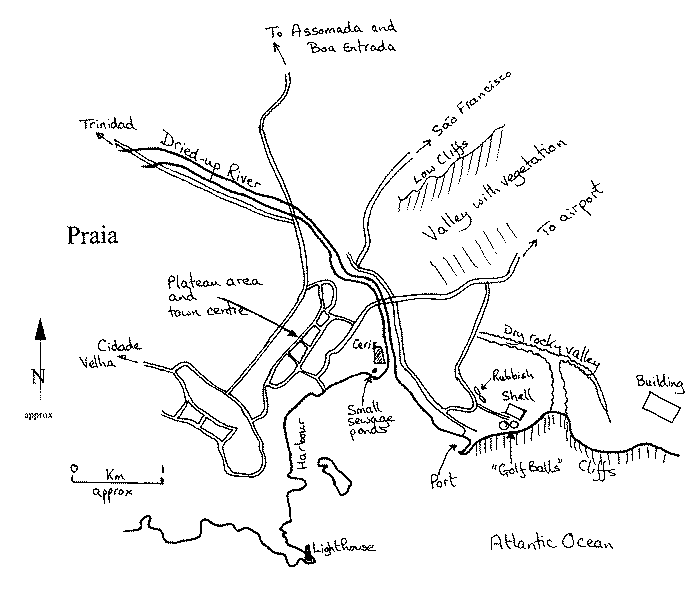
A room costs between 900 CVEsc (single without bathroom) to 1,900 CVEsc (double with bathroom). I paid 1,100 CVEsc for a single with bathroom. From the street this place looks like a run-down workhouse, and no sign is displayed outside indicating it as a Residencial. However, all the taxi drivers know it. It is conveniently located adjacent to a supermarket, and across the street from the TACV office. A little farther along the road one can find the Residencial Solmar which is slightly more expensive, and other establishments can be found nearby. For those with money to burn, several expensive beach resorts are located along the coast near Praia. I ate at the Vila Doce restaurant, a few blocks away, which can be recommended.
Probably the best place to start birding in Praia is to take a taxi to the Shell terminal (200 CVEsc) and walk along the top of the arid cliffs to the east of town. The Shell terminal is situated above the port and is easily identified by the two huge "golf ball" tanks perched atop the cliff. Alexander's Kestrel nests in the terminal buildings, and Cape Verde Peregrine has been seen along these cliffs more than once. Red-billed Tropicbird nests in small numbers. Other birds in the general area include Black-crowned Finch-Lark (along the road amongst the rubbish), Bar-tailed Lark, Cream-coloured Courser and Cape Verde Swift. A walk of a couple of kilometres eastward along the cliffs will bring you to a small, sandy, and secluded beach - nice place to rest -backed by a small agricultural valley which is probably good for migrants.
Species recorded in and around Praia:
Cape Verde Shearwater 1 |
Ring-necked Parakeet 2 |
Site 2. Boa Entrada, Santiago
A huge Kapok tree just outside the village of Boa Entrada holds one of the two known, small colonies of Cape Verde Heron. As the main breeding season for the Cape Verde Heron can finish anywhere between December and March it is important to visit this site early on in the trip. To be absolutely sure of seeing the heron it is necessary to visit shortly after the rains (usually August to November), as these birds are almost impossible to find away from their breeding sites.
To reach Boa Entrada, take an aluguer from Praia to Assomada (200 CVEsc, 75 minutes). From there walk the couple of kilometres to Boa Entrada or ask the driver to drop you (about 400 CVEsc extra, down a rough track). The track to Boa Entrada can be found about 500 metres north of town along the road to Tarrafal. A small shop by the turn-off is called Officina Carpentaria Marecenaria Stofo.
All the local people know Boa Entrada, so it is impossible to get lost - just keep asking. Shortly after taking the track, which is at the top of a ridge, it opens out with excellent views over a wide valley and the village of Boa Entrada. The Kapok tree of the heron colony can be seen at the bottom of the valley behind the village. The track winds down through the village and then along the valley bottom, which is largely given over to agriculture.
Walking down though the village you will be the delight and centre of attraction for the small children - few overseas visitors come this way.
|
Cape Verde Cane-Warbler can be found in any of the trees and denser vegetation in the area, and Spanish Sparrow, Grey-headed Kingfisher and Common Waxbill are common. |
Species recorded from Boa Entrada:
Cape Verde Heron |
Cape Verde Cane-Warbler 4+ |
Site 3. São Jorge dos Orgãos, Santiago
En route between Praia to Assomada you pass though the village of João Teves, a few 100 metres or so beyond which is a left - south - turnoff to São Jorge dos Orgãos. This area, as well as the road between João Teves and Picos, has good birding and is the best area on Santiago to look for Cape Verde Buzzard. A good site for the buzzard (W. Mylemans pers. comm.) is just west of Picos where the elevation offers good views of the surrounding valleys. The interior mountains of the Serra do Pico da Antónia, above São Jorge, now a national park, are probably the area where Cape Verde Heron resides outside the breeding season, though access is difficult. This was also the last stronghold on Santiago of the critically endangered Cape Verde Kite, which is now almost certainly extinct on Santiago.
From Praia take an aluguer travelling toward Tarrafal or Assomada and ask to be dropped at the turning to São Jorge dos Orgãos (150 CVEsc, 60 minutes). Bird along the road to, and beyond, the village. The valleys and hills around São Jorge dos Orgãos are regular sites for Cape Verde Buzzard, Cape Verde Barn-Owl, Helmeted Guineafowl and Cape Verde Cane-Warbler.
Slightly expensive (2,000 CVEsc?), but supposedly good accommodation is available at Hotel Rancho Relax in São Jorge dos Orgãos, which also has a cafe and shop. The town of São Domingos a few kilometres southeast of São Jorge dos Orgãos formerly held breeding Cape Verde Heron (until the trees were cut down), and should still hold Cape Verde Buzzard (though non reported there by Bakker and van Dijk (1996)).
Species recorded from São Jorge dos Orgãos:
Alexander's Kestrel |
Brown-necked Raven |
Site 4. Banana de Ribeira Montanha, Santiago
Banana was visited due to the Cape Verde Heron colony at Boa Entrada being empty. Not surprisingly, but still disappointingly, the colony at Banana was also devoid of birds; breeding having finished. Not having any directions, save for a dot on a map (Hazevoet 1992), Banana de Ribeira Montanha proved difficult to find. Mostly this was due to the locals not understanding the we were interested in the place Banana, and not the product bananas. I suspect the place name Banana is rather common in Cape Verde, and first attempts found us being dropped off at banana plantations near Pedro Badejo!

The Ribeira Montanha is the valley running southwest-northeast between João Teves and Pedro Badejo hidden by a ridge on the western side of the João Teves to Pedra Badejo road. The village of Banana lies within the valley about 5 km before Pedra Badejo. The turn-off is a stone road (the only stone road in this area), and is just past a house and culvert. To reach this area from Praia it is easiest to take an aluguer to João Teves (150 CVEsc, 60 minutes) and then another toward Pedra Badejo (50 CVEsc, 20 minutes). Alternatively, and slightly longer, take one to Pedra Badejo (100 CVEsc) and then another toward João Teves (50 CVEsc). Ask the aluguer driver to drop you off at the turning as mentioned above. From here it is a 400 metre walk to the top of the ridge and a further 400 metres down the other side onto the valley floor and the scattered houses which make up the village of Banana.
The Cape Verde Heron colony is located in the crown of a Mahogany tree about a two kilometre walk up the valley, just after the football pitch. As at Boa Entrada, the large size of the tree makes it impossible to miss. We saw a single Cape Verde Cane-Warbler in the tree. When questioned, local people were aware of the heron colony, and also remarked on the number of Helmeted Guineafowl in the area. However, all we saw were the 'domesticated' version. No food, water or accommodation is available; the closest would be at Pedra Badejo.
Species recorded from Banana de Ribeira Montanha:
Cape Verde Heron |
Cape Verde Cane-Warbler 1 |
Site 5. Pedra Badejo Lagoons, Santiago
Two lagoons (really just large pools) surrounded with scrub, along the coast just east of Pedra Badejo, make an interesting birding spot for waders and migrants. Formerly, reeds and other marshy vegetation held breeding Moorhen (now extirpated) and even attracted Cape Verde Heron. Now however, too much disturbance and less rainfall have reduced the pools to little more than muddy patches. The two pools, separated by a kilometre or so, can be found by simply walking eastward along the coast from town. Pedra Badejo is reached by frequent aluguer from Praia (100 CVEsc, 60 minutes). As the town is a reasonable size, food and water can be bought. Presumably basic accommodation can also be found.
Species recorded at Pedra Badejo Lagoons (wader list not complete, as any species could potentially turn up):
Brown Booby |
Black-winged Stilt 1 |
Site 6. Cidade Velha, Santiago
The picturesque village of Cidade Velha, 12 kilometres southwest of Praia, was visited on the last day of my trip as a potential site for Cape Verde Peregrine. Cidade Velha was the first European settlement to be built in the tropics and dates back to the 15th century. The restored fortifications above the town make an ideal observation point over the village and the impressive cliff-lined valley that reaches inland from the harbour. If ever there was a good looking peregrine site, this qualifies. Alas however none was found. All aluguers ploughing the coastal route between Praia and Porto Gouveia pass through Cidade Velha (80 CVEsc, 30 minutes). A few small shops and bars provide basic food and water needs.
Species recorded at Cidade Velha:
Alexander's Kestrel 2 |
Cape Verde Swift 2+ |
Site 7. Vila de Ribeira Grande, Santo Antão
Santo Antão is one of the most rugged and scenically attractive on the Cape Verde islands, and a visit is thoroughly recommended. Although, due to terrain, much of the island is inaccessible, good access and birding can be found at the northern end of the island around Vila de Ribeira Grande. The main ornithological attraction is the last remaining Cape Verde Kites, which are known from the hills above Vila de Ribeira Grande in the northeast, and Tarrafal in the southwest. Only a handful of birds remain, and luck is required to see one.
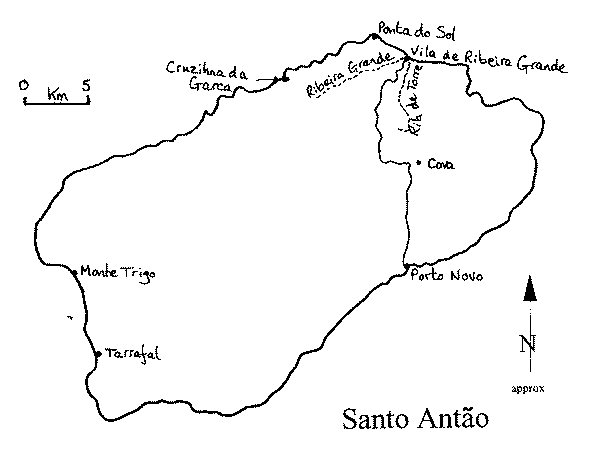
Santo Antão is also a stronghold for Cape Verde Buzzard, and good numbers of Cape Verde Petrel and Cape Verde Shearwater can be seen offshore, particularly from the headland at Ponto do Sol.
|
Santo Antão is accessed via São Vicente - either by ferry into Porto Novo, or by internal flight from Praia or Sal. The airport at Ponto do Sol, is a four kilometre taxi ride (400 CVEsc) from Vila de Ribeira Grande. Accommodation in Vila de Ribeira Grande is available at the Residencial Aliança (1700 CVEsc/double, 1,500 CVEsc/single inc. breakfast), or another (don't know the name) slightly cheaper, though the later seems always to be full. Evening meals at the Aliança were simple but excellent. A fair selection of water, friut juice and food is available from a couple of small stores in Vila de Ribeira Grande. Birding can be done simply by walking out of town along either of the two huge valleys - Ribeira de Torre and Ribeira Grande - that come together at Vila de Ribeira Grande. Both valleys are inhabited and farmed, and a driveable track runs along the bottom of each. Ribeira de Torre runs southward from Vila de Ribeira Grande, and is drivable for about five kilometres after which a steep trail continues a further 2-3 kilometres to end in the 'caldera' a massive circle of cliffs. Cape Verde Buzzard is regularly seen in the valley, and Cape Verde Kite occurs occasionally as well. The valley along Ribeira Grande is driveable all the way to Cruzinha da Garça on the coast; a distance of about 20 kilometres. Another possibility, and probably the best strategy for finding the Cape Verde Kite is to find a high viewpoint and wait. The road from Vila de Ribeira Grande to Porto Novo runs along the top of the ridge between Ribeira Grande and Ribeira de Torre, and offers impressive views into both. I saw a single Cape Verde Kite cross the ridge between the two about five kilometres out along this road. |
This was at the point where looking down at the tennis court in Ribeira Grande you would be looking directly along the net (see map). A white wall 30 metres long, 3 metres high borders the road here. A farther 500 metres brings you to a good lookout point. The high point of this road is at about 15 kilometres from Vila de Ribeira Grande around the extinct volcano at Cova. Taking an aluguer to here (200 CVEsc), and spending the day walking back to Vila de Ribeira Grande will probably result in all the interesting birds of the area being seen. Egyptian Vulture is fairly common.
I was told that another good area to watch for the kite is to take the rough road along the eastern ridge to the east of the Ribeira de Torre, and find a suitable viewpoint on the mountainside; I had insufficient time to try it. They are occasionally seen in the harbour at Ponta do Sol.
To seawatch from Ponta do Sol, return to the airport, and walk across the runway (usually deserted, and locals were crossing it to get to the beach) to the small trig point that sits on the end of a wall built along the rocks at the most northerly point of the island. Although the trig point makes a handy tripod, the stiff sea-breeze can be a problem, and I found using the top of the wall and sheltering from the wind behind the wall a better solution.
Species recorded around Vila de Ribeira Grande:
Cape Verde Petrel 26+ |
Neglected Kestrel 7+ |
Site 8. Tarrafal, Santo Antão
The area between Tarrafal and Monte Trigo in the remote southwest is the only other place from which the Cape Verde Kite has been recorded recently. Other than hiring a boat, Tarrafal can be accessed by road (rough track) from Porto Novo, where it is necessary to hire a 4x4. The journey takes two hours from Porto Novo. The easiest way to arrange this might be to contact one of the local operators (try asking at the Residencial Aliança) who specialise in walking and trekking tours of the interior.
Site 9. Porto Novo - Mindelo ferry, Santo Antão - São Vicente
Two ferries crisscross the 20 kilometre gap between Santo Antão and São Vicente. Both operate daily, except Sunday, and strangely, both run at the same time (in case one capsizes?). Schedules vary with the day of the week (and time of the year?), so ask locally for up-to-date information. The usual schedule is from Mindelo to Porto Novo at 08h00, and from Porto Novo to Mindelo at 11h00 or 17h00. The cost of a one-way ticket is 430 CVEsc. Although you can buy tickets on the dockside, in Porto Novo tickets are most easily bought from the Sumotrans ticket office which is situated opposite the Shell petrol station on the road just above the harbour (easily visible from the dockside).
The crossing takes one hour and, in principle, can provide views of Cape Verde Petrel, Cape Verde Shearwater, and maybe other interesting seabirds. However, save for the Osprey which nests on the offshore island as you approach Mindelo, I saw absolutely zero.
Site 10. Mindelo Sewage Ponds, São Vicente
|
Mindelo town and harbour have a rather run down and depressing atmosphere about them; its sole existence seemingly based on it being the main sea port. Although it is not essential to visit São Vicente specifically to search for any of the Cape Verde specialities, most visitors are likely to find themselves at least passing through if visiting Santo Antão. The airport lies about 15 kilometres southeast of Mindelo. A taxi to town costs 500 CVEsc, or you can wait for one of the infrequent aluguers travelling from São Pedro. The Santo Antão - São Vicente ferry pulls into the northern end of the harbour, from which it is a short 100 CVEsc taxi-ride to any of the residencials in town. |
One of the cheaper residencials used by travellers is the Pensão Chave d'Ouro, situated fairly close to the harbour. A room costs 900 CVEsc/double. One report rated highly the restaurant, but the dinner I tried was mediocre. I stayed at, and would recommend, the Residencial Sodade (1,500 CVEsc/single inc. breakfast) which is situated at the back side of the town, and has an excellent sun terrace on the roof with a good restaurant and a view across the town and harbour.
|
Within such an arid landscape, the large sewage ponds just outside Mindelo are a powerful magnet to both resident and migrant species. The ponds are packed with waders which commute between the ponds and the nearby beach with the rising and falling tides. All sorts of rarities turn up on migration. |
Due to a large area of acacia scrub, the ponds cannot be seen from the road. They can be found by following the dirt access road which turns off the main road just after the Shell facility, or by cutting through the scrub, following the line of telephone/power cables running from the back of the Shell facilities to the corner of the sewage ponds. A collection of ten wind turbines is also visible on the hill behind. Although the ponds are fenced and closed to the public, the workers and night watchman are all very friendly and seem accustomed to having visiting birders, so just ask at the gate.
Species recorded at Mindelo Sewage Ponds:
Little Egret 50 |
Common Ringed Plover 12 |
Site 11. São Pedro Lagoon, São Vicente
The term 'lagoon' is a rather grandiose and misleading definition for the intertidal area of wet sand at São Pedro. This wet area on the beach is just on the bend of the main road between the airport and São Pedro, and can be walked to/from the airport (less than a kilometre) for those with an hour to kill while waiting for a plane.
Species recorded at São Pedro Lagoon:
Cape Verde Shearwater |
Common Ringed Plover 4 |
Site 12. Tarrafal and the Fajã Valley, São Nicolau
Tarrafal is the essential stop-off point for those wishing to visit the islet of Raso for Raso Lark. São Nicolau is reached by plane from either Sal or São Vicente. From the airport, take a taxi to Vila da Ribeira Brava (500 CVEsc, 10 minutes), and from there an aluguer to Tarrafal (200-300 CVEsc), or if no through aluguer is available take one to Fajã and change.
|
Good accommodation and meals are available at the Casa de Pasto Alice, a small guesthouse right on the sea front. A single room cost 1,000 CVEsc including breakfast. Evening meals cost a very reasonable 800 CVEsc. The owners also run a small shop beneath the guesthouse that has a fair range of goods including home-made cake. Other small shops and a bakery are nearby. The owner can put you in contact with a boat captain to take you to Raso. |
As the barren headlands, cliffs, and rocky plains around Tarrafal have few interesting birds other than a few seabirds or waders, the most interesting place to visit is the fertile Fajã Valley, which is probably the easiest place in Cape Verde (and the Western Palaearctic) to see Helmeted Guineafowl. Additionally the scenery is a pleasure. Once in the valley, anywhere is probably as good as anywhere else for the guineafowl, but two places where they are regularly seen are near Cachaço and Cabeçalinha (see map, HGF = Helmeted Guineafowl).
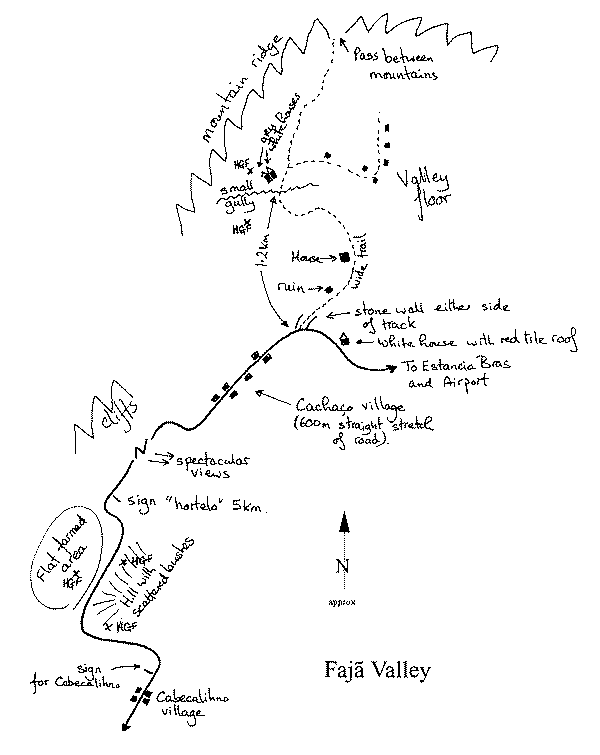
From Tarrafal take an aluguer to Cachaço (80 CVEsc), and find the obvious sharp bend at the northern end of the village (see map). At the bend, between two stone walls, a trail leads down the valley and can be followed for some distance. If you are here early in the morning you will almost certainly here guineafowl calling from the fields above the houses on the left. They appear to roost in the trees above the arable land and come down to feed during the day. I saw at least nine calling from the tops of Centaury plants and running around in the fields near in the gully. This trail continues toward a pass to the northeast and would make an interesting walk for a few hours.
Cabeçalinho is a small village - nothing more than a couple of houses passed en route between Tarrafal and Cachaço. About 1 kilometre after the village the road passes along the edge of a scrub-covered hill with a flat farmed area on the west. At least 31 guineafowl were seen here crossing the road, and is the same place where a number were seen in March 96 (Bakker and van Dijk, 1996). However, others have spent time in this area and dipped (Mylemans, pers. comm.). The high cliffs at Estancia Bras at the northern end of the valley make a good seawatching point.
Species recorded in the Fajã Valley and around Tarrafal:
Little Egret 1 |
Cape Verde Swift 5+ |
Site 13. Raso
The trip to the uninhabited Ilhéu de Raso was the highlight of my trip. However, the two hour crossing is not for the faint-hearted - the boats are small and the sea very rough. Sea-sickness tablets highly recommended. Raso is reached by hiring a small fishing boat from the Tarrafal harbour on São Nicolau. The owner of the Casa de Pasto Alice (see Tarrafal section above), can put you in contact with one of the fishermen. I was introduced to Captain "Rockie" Joaquin Soares, a jovial and reliable character who agreed to take me across for the day for 12,000 CVEsc, leaving at 06h00. Much bargaining will be required to lessen this price. The captain of the fishing boat 'Alcatraz' has also taken people in the past.
|
One day is sufficient to see the Raso Lark and seabirds, but staying over night could also be interesting for those with more time, as Raso is home to numerous nesting petrels and shearwaters. Seawatching from the cliffs on Raso might also be beneficial, but I saw little. Whether you stay on Raso for one or two days, the boat captain will drop you, and spend the rest of the time fishing in the area, as the journey back is too long and rough to do twice in a day. Raso has no landing place, and it is necessary to jump off onto slippery rocks, before the boat gets heaved onto them. Footwear, preferably not flip-flops, is advisable here. Also be prepared to get soaked on the crossing. |
I found binoculars useless - they are better packed in plastic inside a backpack - and besides, birds pass right over and beside the boat, so there are no identification problems. As I didn't bring a waterproof jacket with me on this trip, Rocqui lent me a pair of, too small, oilskins.
The drop-off point is on the south side of Raso, just west of the main Red-billed Tropicbird and Brown Booby colony. After scrambling up the low cliff, you are on the main rocky plateau of the island. Raso Lark can be found anywhere on the sandy, level areas, particularly in any of the few grassy places. During March '97 the birds were singing, and easy to find.
The crossing to Raso is the best place to encounter Cape Verde Little Shearwater, especially as one nears Raso. Stunning views of Cape Verde Shearwater are guaranteed, and one should find Cape Verde Petrel. A noticeable feature of Raso is the tameness of the Cape Verde Sparrow. Almost desperate for water, birds fly up to you as soon as you stop, and some will almost drink out of your hand.
Please note that the seabirds on Raso are very prone to disturbance at their colonies. Furthermore, officially Raso is closed to the public, and permission is required to visit, though where to obtain this is not clear. However, no enforcement of regulations takes place, and locals still visit, and much evidence of catching and killing of seabirds can be found.
Species recorded on Raso and crossing from São Nicolau:
Band-rumped Storm-Petrel |
Neglected Kestrel 1 |
Site 14. Pedra de Lume Saltpans, Sal
The Pedra de Lume saltpans, east of Espargos, lie inside an extinct volcano. They cannot be seen until exiting the short tunnel through the volcano rim, where the view across them is memorable. These saline pans are the only remaining breeding site in Cape Verde for Black-winged Stilt.
Accommodation is readily found in Espargos, a two kilometre, five minute, 150 CVEsc taxi ride from the airport just south of town. I stayed at the Casa da Ángela (1,100 CVEsc); one of several similar establishments found in the town. |
|
Others have stayed at the Residencial Central (1,800 CVEsc/double) or the Paz e Bem. The supermarket under the Residencial Central in the main plaza was well stocked. At night I ate at the Salinas fish restaurant which, although excellent, had a rather limited menu. Evidently though this place is the local hangout for foreigners, and Peace Corp volunteers.
To reach the saltpans take a taxi (400 CVEsc), aluguer (80 CVEsc, but infrequent), hitch, or walk the seven kilometres, to the almost uninhabited village of Pedra de Lume. The only thing this place needs to be right out of a western movie is a few tumbleweeds rolling down the street. From here follow the derelict telepherique the kilometre to the saltpans. Early morning or evening is advisable here as the salt, sand and sun are rather vicious during the day. As these saltpans are one of the few tourist attractions on the island others may well also visit. If you feel like it, a touristic thing to do is to jump in some of the salt pools, though washing the salt off might prove difficult.
Species recorded at Pedra de Lume Saltpans:
Alexander's Kestrel |
Cream-coloured Courser 3 |
Site 15. Santa Maria Saltpans, Sal
A further collection of saltpans is situated at the southern end of Sal. By no means in such an impressive surrounding as Pedra de Lume, and seemingly now somewhat neglected (out of production?), these saltpans are nonetheless interesting for waders for those with a few hours to spare.
|
Santa Maria is situated at the end of the only north-south road on the island, about 17 kilometres from Espargos. Although the town itself is rather unexciting, the pure white sandy beaches and beautiful sea make this one of the main tourist accommodation centres. Several luxury resorts are found along the coast, though tourism in Cape Verde is such that you still have the beach virtually to yourself. |
After walking through the saltpans, a few pools can be found to the west of town behind the beach resorts (though they were being built on), as well as a lagoon (then dry) at the western point of the island. Santa Maria is easily accessible from Espargos by frequent aluguer (70 CVEsc, 20 minutes).
Species recorded at Santa Maria:
Brown Booby 2 |
Black-winged Stilt 3 |
Site 16. Rabil Lagoon and Sal-Rei, Boa Vista
The island of Boa Vista, ornithologically one of the more interesting, is connected by air from either Sal or Praia. A taxi from the airport, 5 kilometres south of the main town of Sal-Rei, costs 400-500 CVEsc. Several basic residencials can be found in town, along with grocery shops, a couple of bars and a bank. I stayed at the Residencial Bon Sossego (1,000 CVEsc/single, 1,500 CVEsc/double inc. breakfast), which was fine. The owner also owns a good Toyota Landcruiser which can be rented for a trip to Curral Velho or elsewhere.
|
The best place to eat appears to be the Restaurant/Bar Naida just around the corner from the Bon Sossego, where an evening meal cost around CVEsc 750. Note that the owner likes customers to book their meals in advance (at least 1-2 hours), so that they have time to prepare. The Swordfish I ate on both evenings was excellent. The small kiosk near the harbour was a good place to sit, drink and write notes during the heat of the day. The permanently wet Rabil Lagoon, one of Cape Verde's migrant birding hotspots, is located about three kilometres south of town, and crossed en route to the airport. Plan on spending at least a couple of half-days here. Yellow-billed Egret, a great rarity in the western palaearctic, sometimes occurs, with two present in both March '96 and March '97 (same birds?). Any kind of rarity is possible, as during my visit Solitary Sandpiper (W. & I. Mylemans) and Black-crowned Night-Heron were found. The surrounding, large area of thorny scrub and trees is very good for migrant passerines. Helmeted Guineafowl, sometimes seen in the area, are the result of recent reintroductions. The species has been introduced many times on Boa Vista, but does not seem able to form a self-sustaining population. To reach the lagoon take a aluguer toward the airport and jump off at the bridge. I found the aluguers only frequent in the early morning and late afternoon; otherwise hitching was easy. During spring, the bridge is the rough dividing line between the permanently wet western half of the lagoon, and the seasonally wet eastern half. |
Walking along both edges of the lagoon is worthwhile, but easier on the southern side, as migratory dunes are found on the northerly side near the beach. Most waders are found at the widest part of the lagoon near the beach. It is also possible to reach the lagoon by walking along the coast from Sal-Rei, although I didn't see very much, and the strong winds and blowing sand from the inland dunes did not make this a pleasant walk. In and around Sal-Rei, there are a small area of saltpans just northeast of town that held a few waders.
Species recorded at Rabil Lagoon:
Red-billed Tropicbird |
Curlew Sandpiper 4 |
Site 17. Ilhéu de Pássaros, Boa Vista
Ilhéu de Pássaros, lies a kilometre offshore from the now derelict village (two houses) of Pássaros. Ilhéu de Pássaros is just one of many such uninhabited islets offshore of western Boa Vista where White-faced Storm-Petrel breeds in relative safety. Small numbers of Band-rumped Petrel also occur, but probably not on Pássaros which holds only around 20-30 pairs of White-faced. The petrels are nocturnal and can be seen coming in from about an hour after dark for the duration of an hour, and the reverse in the morning, starting a couple of hours before dawn. The islet is very small (about 50 metres across), and it is absolutely imperative that visitors stay on the stony beach that rings the sandy area containing the breeding burrows. These birds are very vulnerable to disturbance.
Because of the currents and reefs that surround the islet, fishermen will make only daylight crossings. Therefore it is necessary to spend the night on the beach and be collected the following morning. A sleeping bag is useful as the temperature drops markedly overnight.
As the village of Pássaros is deserted, arrangements must be made a day or so in advance, including transport from Sal-Rei, as a 4x4 is required to get to Pássaros. Although it is possible to ask for fishermen in the villages of João Galego or Fundo de Figueiras, the easiest way to arrange the whole thing is to contact Rui in Sal-Rei. He works at the airport, and lives in the first house in Sal-Rei just after the EMPA building. Rui speaks English and appears to have connections into tourism, and can arrange 4x4 vehicle with driver, boat and fisherman. You should contact him as soon as you arrive and give him a day or two to make the arrangements. The cost for the 4x4 and driver was 5,000 CVEsc, and for the boat 2,000 CVEsc. The boat would normally be about 4,000 CVEsc, except that the engine had broken down and it was necessary to row across (a long and painful process due to the wind and currents).
Species recorded at Pássaros:
Cape Verde Shearwater 1 |
Osprey 1 |
Site 18. Curral Velho, Boa Vista
Ilhéu de Curral Velho, now holds probably the last remaining breeding Magnificent Frigatebird in the eastern Atlantic. During my visit only one pair was found, breeding among the Brown Booby colony there. The ilhéu is about a kilometre offshore and easily visible from the dunes south of the deserted village of Curral Velho.
Curral Velho is remote; the closest one can reach by public aluguer is Povoação Velha (100 CVEsc). From there it is a tough 15 kilometre walk, each way down to, and along the coast to Ilhéu de Curral Velho. However, as the frigatebirds wander along the coast you have a small chance of seeing one. I didn't visit Povoação Velha area - see Bakker and van Dijk (1996) for more details. Take plenty of water as it is hot and isolated. Black-crowned Finch-Lark, Bar-tailed Lark and Greater Hoopoe-Lark are common.
The alternative to this masochistic approach, and more likely to produce the frigatebird, is to hire a 4x4 and driver to take you to Curral Velho. This will cost 5,000-6,000 CVEsc, and the journey takes about 90 minutes each way. The birding en route is good for Greater Hoopoe-Lark, Bar-tailed Lark, Black-crowned Finch-Lark, and possibly Black Kite. Due to the deep sand dunes it is necessary to walk the last kilometre up onto the dunes to overlook the Ilhéu de Curral Velho. A scope is useful to obtain better views of the frigatebird. The beaches and dunes are stunningly beautiful. In addition, a series of palms and bushes are located near the village. These can be interesting for migrants.
Species recorded around Curral Velho:
Magnificent Frigatebird 1 |
Kentish Plover 2 |
Section 1 - Introduction, logistics, itinerary and general information.
Section 2 - Birding sites.
Section 3 - Systematic list.

